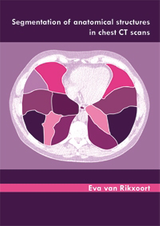Segmentation of anatomical structures in chest CT scans
E. van Rikxoort
- Promotor: M. Viergever and W. Prokop
- Copromotor: B. van Ginneken
- Graduation year: 2009
- Utrecht University
Abstract
In this thesis, methods are described for the automatic segmentation of anatomical structures from chest CT scans. First, a method to segment the lungs from chest CT scans is presented. Standard lung segmentation algorithms rely on large attenuation differences between the lungs and the surrounding tissue. Those methods are fast and perform well in a large percentage of cases. However, when abnormalities are present, such algorithms often fail. The few methods that have been proposed to handle such cases are too time consuming to be applied in clinical practice. We propose a method that combines two existing methods using automatic error detection. This method is shown to perform substantially better than a standard algorithm at a relatively low increase in computational cost. After the lungs are segmented, the fissures inside the lungs are extracted. The goal of the fissure extraction is to detect both the lobar and the accessory fissures. To this end, a supervised filter based on pattern recognition techniques is designed. It is shown that the filter is able to detect fissures with a high accuracy. In a next chapter, the lungs and fissures are used to identify lobes and segments in the lungs. First, the lobes are extracted using a supervised method that employs the lobar fissures and the lungs. Since there are no physical boundaries between the segments, a method is designed that assigns to each voxel a probability that it belongs to a segment based on the position in the lobe and the position relative to the closest fissure. It is shown that the method is able to assign a set of points in each scan to the correct segment with an accuracy comparable to the inter- and intra-observer agreement. In the next chapter, a method to extract the airways from chest CT scans is presented. From an automatically determined seed point in the trachea, a tree structure is grown based on a set of rules. Along with a segmentation of the bronchial tree, a method to extract the anatomical labels for airway branches up to segmental level is presented. The method is shown to perform well in different types of CT scans. The next chapter is a methodological chapter that describes two new frameworks for multi-atlas segmentation. The frameworks improve upon standard multi-atlas segmentation by including an automatic atlas selection, a stopping criterion that determines when no more improvement is expected, and a method to determine which area of a scan would benefit from additional atlases. The method is applied to segmentation of the heart in chest CT scans and, to show the general applicability, segmentation of the caudate nucleus in brain MR scans. In the final chapter, a method to segment the lobes is presented that combines the segmentation results and methodology described in previous chapters to enhance performance. The method incorporates contextual information using automatic lung, fissure, and bronchial tree segmentations. Shape information is incorporated using a multi-atlas approach. The method is shown to perform well in data with incomplete lobar fissures.
